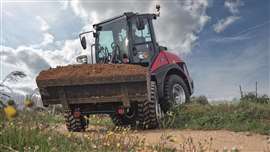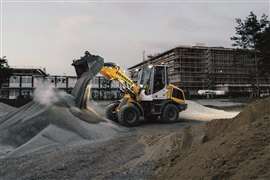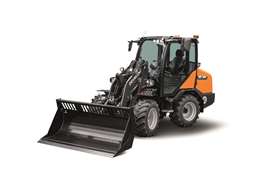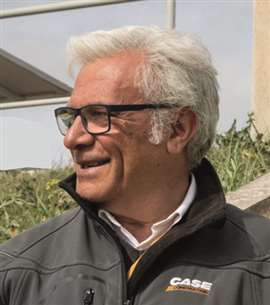Wheeled loaders: What’s next in their evolution?
15 December 2023
As construction projects continue to evolve in complexity and scale, the demand for equipment that seamlessly integrates power, agility and precision has never been greater. Wheeled loaders are at the forefront of this evolution, defining new standards for productivity and adaptability.
Modern construction sites are everchanging and this means so are their needs. Projects require increased technology, enhanced systems and improved productivity.
Philipp Schwartz, product manager of wheeled loaders in the Europe, Middle East and Africa region at Yanmar, asserts that the design and technology of wheeled loaders have evolved in recent years.
 The V7 is the smallest machine in Yanmar’s range (Photo: Yanmar)
The V7 is the smallest machine in Yanmar’s range (Photo: Yanmar)
“The biggest impact was given by the European Union with the engine emission regulation to reduce nitrogen oxides and particulate matter. This has impacted the design and the required space due to the exhaust after-gas treatments, like the diesel particulate filter. These particulate filters also require space.”
Manufacturers have had to change the design of their equipment to ensure that everything fits into the machine.
“One part that also goes with an engine downgrade is that some manufacturers reduced the engine power to avoid a certain emission level,” says Schwartz.
Things have also changed on the supplier side as hydraulic drive trains have become more efficient over the years, thanks to research and development.
Powertrain technology
Ladislav Junek, product manager of wheeled loaders at Develon Europe, also agrees that engine and powertrain technology have been instrumental in wheeled loaders’ current evolution.
“Engine technology has improved significantly,” says Junek. “This has resulted in better fuel efficiency and not only reduces total cost of ownership but also fits in with the growing emphasis on environmentally friendly design.”
Junek also highlights that Continuously Variable Transmission (CVT) is becoming more popular and accepted. “CVT can offer better fuel efficiency than conventional powershift transmissions – up to 25%. CVT allows the engine to run at its most efficient speed, improving fuel efficiency and reducing emissions,” he says.
Fernando Cuppone, wheeled loader product management at Case Construction Equipment, says that a continual challenge is how to improve productivity whilst reducing ownership and running costs.
“This may seem contradictory, since the common idea is that to increase productivity we need to increase the power and, consequently, the running costs. That is not always true: accurate design aided by the latest technology can reverse this idea,” reveals Cuppone.
 Philipp Schwartz, product manager, wheeled loaders, EMEA region, Yanmar (Photo: Yanmar)
Philipp Schwartz, product manager, wheeled loaders, EMEA region, Yanmar (Photo: Yanmar)
While the design and technology of wheeled loaders have changed over the years, upskilling and retaining workers within the industry is also key to their development.
“Users have difficulties recruiting qualified operators and/or training their current workforce. To help them, we are packing our wheel loaders with smart technologies and easy-to-use controls to boost both operator and site operator efficiencies,” comments Thierry Brasseur, senior market professional for medium wheel loaders at Caterpillar.
“For example, all our wheeled loaders can now be equipped with our unique steering joystick. Positioned controlled with force feedback, it is easy to use in all applications and significantly reduces operator fatigue over their work shift. ‘Inform’ and ‘Assist’ features help the operator improve their operating technique in different applications.”
Brasseur anticipates that finding methods to address the operator shortage that the construction sector faces, as well as ensure that operators have adequate training, will continue to be vital to the evolution of wheeled loaders.
Improving overall efficiency and reducing operating costs by leveraging digitalisation and new technologies are also changes that will need to be continually prioritised.
Electrifying construction
Electrification remains a key trend across the majority of construction equipment manufacturers, and compact wheeled loaders are one of the most frequently electrified products.
Yanmar’s Schwartz believes that it is the biggest trend in the industry and one that all manufacturers have in common.
“We saw at Bauma Munich that it was not only wheeled loaders, but it is also electric mini excavators and medium-sized excavators,” he says. “Every manufacturer was launching at least one electric product, even if that product was a prototype.”
More recently, Liebherr launched the L 507 E battery-electric wheeled loader, the company’s first electric wheeled loader.
 The new L 507 electric wheeled loader (Photo: Liebherr)
The new L 507 electric wheeled loader (Photo: Liebherr)
The machine, which is based on the Liebherr L 507 Stereo wheeled loader, is said to have a running time of up to eight hours depending on operating conditions and offers performance equal to a conventionally powered machine in the same size class, the company said.
The battery-electric drive means that full power is available at all times, giving the operator what Liebherr calls “dynamic working movements and responsive handling.”
Meanwhile, low noise emissions and the removal of onsite CO2 emissions make it suitable for inner city areas where exhaust and noise emissions are factors.
The high-voltage battery system has been specially developed for the new model and delivers “powerful performance and efficient charging”, while the modular battery design means a second lithium-ion battery can be installed to increase the run time.
The battery can be fully charged in approximately one and a half to three hours depending on the on-board charging technology and power rating. At the same time, the energy generated downhill and during braking is fed back into the battery through recuperation to increase efficiency.
It features a maximum tipping load of 3.7 tonnes, while its maximum operating weight of 6.1 tonnes is heavier than the conventional model’s 5.8 tonnes.
Future technology solutions
As manufacturers race to electrify more and more equipment it begs the question; what’s next? For Schwartz, electrification is simply acting as a bridge for further technology and is also dependent on political decisions.
“It is not 100% where the industry will go. I think there is a lot of political discussion on what we will run on in the future. I think the direction will be whatever results out of the political discussion – that is the one we will have to go with.”
 The Develon DL60 wheeled loader (Photo: Develon)
The Develon DL60 wheeled loader (Photo: Develon)
He adds that there are a multitude of advancements and innovations on the horizon for wheeled loader technology. “The kind of possibilities with low voltage and high voltage within the system are bringing us to different machine concepts. If you have high voltage, you can reduce the parts as well as the cost. On the other side, you have to have a higher education training level to enable you to work on high voltage.”
Schwartz adds that, “I also think that hybrid technology is something that the industry is looking at or working on, but that’s more on heavier machines. For my wheeled loader size, for which I am responsible, there is no hybrid solution available, and it is not under investigation.
“For the time being, connectivity will be the biggest topic because normally the user does not have an exclusively Yanmar fleet. And they need to connect their data management system. Connectivity is, and will, become a big driver for the data exchange.” To address the challenges surrounding data, Schwartz says that Yanmar plans to launch new hardware for their telematic system, called Smart Assist Remote (SAR). This includes both 5G and 4G telecommunications.
Data challenges in construction
Cuppone of Case Construction also believes that the relationship between hardware and software will be a driver for development in the future.
“The widespread use of electronic hardware and related software for the functional management of a wheeled loader is, in reality, a strong enabling factor for future technological development.
 Fernando Cuppone, wheeled loader product management, Case Construction Equipment (Photo: Case Construction Equipment)
Fernando Cuppone, wheeled loader product management, Case Construction Equipment (Photo: Case Construction Equipment)
“An accurate, and hopefully responsible, use of artificial intelligence could lead the operator to optimise work in certain construction site conditions and/or improve the safety features already present, with the aim of obtaining semi-autonomous driving, in the medium term or, in the long term, even fully autonomous driving.”
There is increasing demand for having fleets under full control, even if they are on different job sites, by receiving real-time reports about productivity, fuel consumption, and correct usage from each of their vehicles.
“The user also aims for peace of mind in terms of maintenance and repair and here connectivity plays an important role. Being able to timely generate alerts on service intervals close to expiration and/or giving the dealer the possibility to perform remote diagnosis in case of equipment’s failure,” says Cuppone.
“Maximising productivity and machine uptime is one of the main targets of every user, and connectivity can help a lot.”
Demands for increased productivity, lower running costs and innovative technology are increasing, and pushing OEMs with their research and development. Times are certainly changing, and it appears that the wheels are well in motion to continue to develop one of construction’s most popular machines.
STAY CONNECTED



Receive the information you need when you need it through our world-leading magazines, newsletters and daily briefings.
CONNECT WITH THE TEAM








